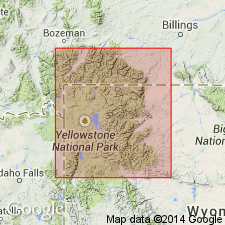
- Usage in publication:
-
- Two Ocean Formation*
- Modifications:
-
- Named
- Dominant lithology:
-
- Volcaniclastics
- AAPG geologic province:
-
- Yellowstone province
Summary:
Named as a formation of Thorofare Creek Group of Absaroka Volcanic Supergroup. Source of name and type area are along the east edge of the Two Ocean Plateau, Yellowstone National Park, Yellowstone province, WY. Is a dark-colored, thick-bedded, coarse, andesitic volcaniclastic unit. The clasts are cobbles and boulders of subvitreous to stony porphyritic andesite containing phenocrysts of hornblende or pyroxene, or both, as well as plagioclase and sparse amounts of biotite in a matrix of sand, silt, and ash. Has some beds of very light gray water-laid ash. Has a maximum thickness of 2,000 ft. Base is marked by an erosional, locally angular unconformity having several hundred ft of relief. Is unconformably overlain by Tepee Trail or by Wiggins Formation. Was called "late basic breccia" by Hague (1899). K-Ar determinations from minerals in pumiceous tuff of 47.9 +/-1.3 m.y. on sanidine and 48.5 +/-1.3 m.y. on biotite 20 ft below top of formation are the bases for the middle Eocene age assignment.
Source: GNU records (USGS DDS-6; Denver GNULEX).
For more information, please contact Nancy Stamm, Geologic Names Committee Secretary.
Asterisk (*) indicates published by U.S. Geological Survey authors.
"No current usage" (†) implies that a name has been abandoned or has fallen into disuse. Former usage and, if known, replacement name given in parentheses ( ).
Slash (/) indicates name conflicts with nomenclatural guidelines (CSN, 1933; ACSN, 1961, 1970; NACSN, 1983, 2005, 2021). May be explained within brackets ([ ]).

